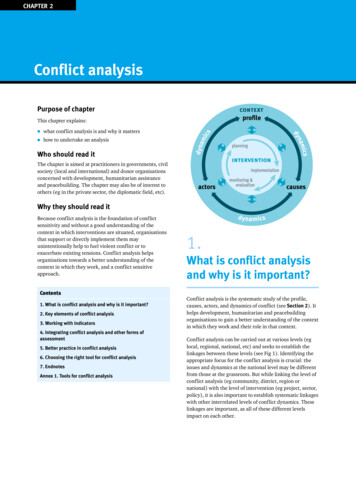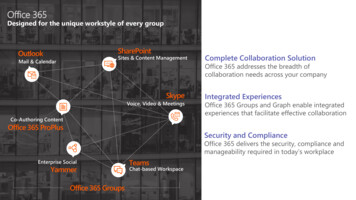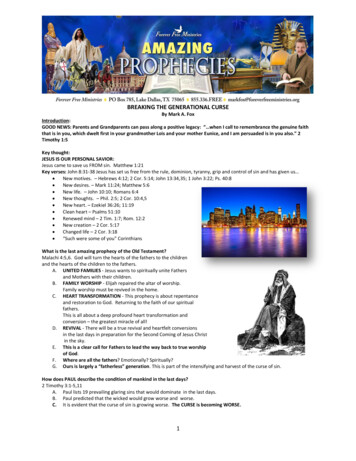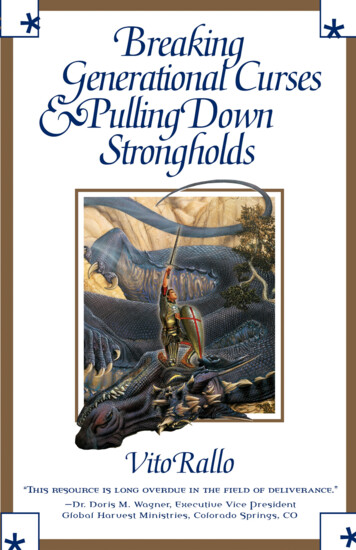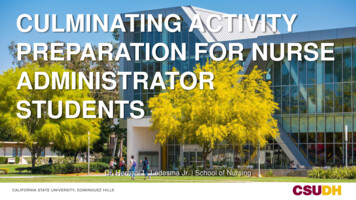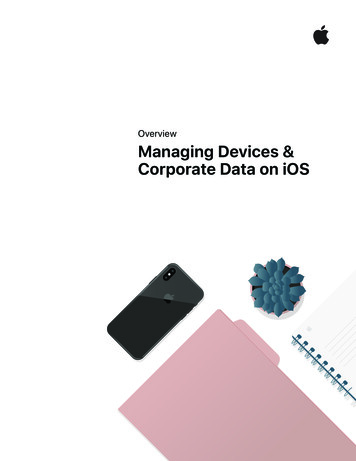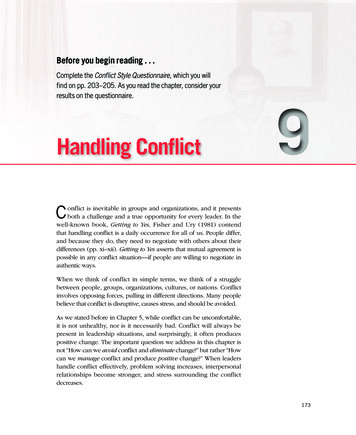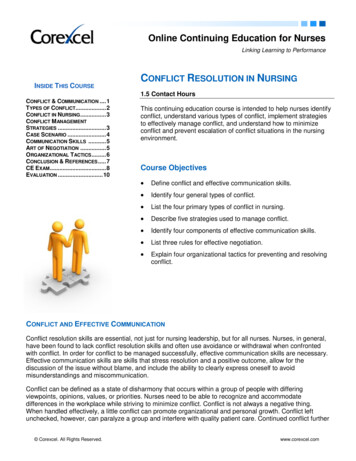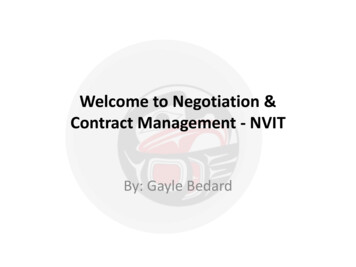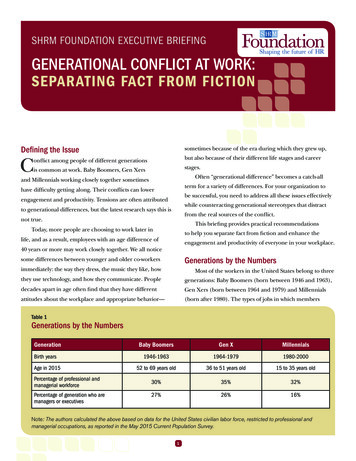
Transcription
SHRM FOUNDATION EXECUTIVE BRIEFINGGENERATIONAL CONFLICT AT WORK:SEPARATING FACT FROM FICTIONDefining the Issuesometimes because of the era during which they grew up,Cbut also because of their different life stages and careeronflict among people of different generationsstages.is common at work. Baby Boomers, Gen XersOften “generational difference” becomes a catch-alland Millennials working closely together sometimesterm for a variety of differences. For your organization tohave difficulty getting along. Their conflicts can lowerbe successful, you need to address all these issues effectivelyengagement and productivity. Tensions are often attributedwhile counteracting generational stereotypes that distractto generational differences, but the latest research says this isfrom the real sources of the conflict.not true.This briefing provides practical recommendationsToday, more people are choosing to work later into help you separate fact from fiction and enhance thelife, and as a result, employees with an age difference ofengagement and productivity of everyone in your workplace.40 years or more may work closely together. We all noticeGenerations by the Numberssome differences between younger and older co-workersimmediately: the way they dress, the music they like, howMost of the workers in the United States belong to threethey use technology, and how they communicate. Peoplegenerations: Baby Boomers (born between 1946 and 1963),decades apart in age often find that they have differentGen Xers (born between 1964 and 1979) and Millennialsattitudes about the workplace and appropriate behavior—(born after 1980). The types of jobs in which membersTable 1Generations by the NumbersGenerationBirth yearsAge in 2015Percentage of professional andmanagerial workforcePercentage of generation who aremanagers or executivesBaby BoomersGen XMillennials1946-19631964-19791980-200052 to 69 years old36 to 51 years old15 to 35 years old30%35%32%27%26%16%Note: The authors calculated the above based on data for the United States civilian labor force, restricted to professional andmanagerial occupations, as reported in the May 2015 Current Population Survey.1
of each generation congregate are not very different, butto consider in designing career opportunities is what anmanagerial and executive positions are more commonindividual wants to accomplish, not what generation he oramong older workers. Only 16 percent of Millennialsshe comes from.currently hold managerial positions, although that is asubstantial number, given their age.Everyone has something to offer your organization, regardless of age.Stereotypes based on age are common in mostMoving Beyond Generations:What Really Mattersorganizations. For example, managers may argue that theWhat employees want usually is a function of their life stage andso they should be quiet, listen and learn rather than putcareer stage, not their generation.forward ideas and suggestions. Others may suggest that theyoungest employees are too young to have much to offer,oldest employees are irrelevant and out-of-date. Clearly, bothThe era during which we grew up helps shape our viewof work, our relationships and our place in the world, butassumptions are wrong. Organizations benefit the most whenwhat we need and want depends on our circumstances at athey are able to leverage diversity of experience and use it toparticular point in time. Our life stage and career stage affectimprove products and processes.what we want, expect and need to be happy and productiveat work.Conflict is typically about power and control, not about generation.Conflicts that appear to be generational are often aboutFor example, people who don’t have children are ina different life stage than those who have children. Thewho has the power to call the shots and who must obey.demands on anyone are different once children arrive,In today’s workplace, conflicts often arise over demandswhether the person is a 24-year-old Millennial or a 44-year-for work-life flexibility. Rules and attitudes are evolving asold-Gen Xer. Employees at the same life stage usually havea result of improvements in technology. Some employeesmore in common than those who are at different life stages.believe most work should be done in the office, but othersdisagree. As the ability to work anywhere and anytimeCareer stage also affects what people want and needat work. A larger percentage of Millennials than Xers orexpands to include more positions, the balance of powerBoomers may seek promotions because they are in earlieramong employees and questions about how each employee’scareer stages. But you should not assume that all Millennialstime is managed can change. Because managers are morewant to be promoted, even if they are working in a joblikely to be members of older generations and frontlinedesigned to train people for higher levels.employees are more likely to be Millennials, conflicts abouthow time is managed are often seen as generational. But theOrganizations should focus on job level and type of occupation,true source of the conflict is power and need for control, notrather than generation, when thinking about development options.generational differences.The development an employee needs depends more oncareer stage than on age or generation. The primary factorReal generational differences are often less important than theyappear.Figure 1There are some real differences between generationsMajor Life Stagesthat are not due to life or career stage. For example,Millennials are more likely to use texting, instant messagingand social media to communicate with their peers; Gen Xersare more likely to use phones and e-mail. These differencesin communication can lead to conflicts, but preferences doshift over time for all generations. For example, Facebook’suser base now includes a majority of the entire U.S.population, and older users are the fastest-growing group.Initially, e-mail was a tool adopted by Gen Xers, but today it isused by all generations at work.2
Figure 2Major Career Stagesexecutives—have similar developmental needs,What matters for your organization is whethergenerational differences have a demonstrable impact in theregardless of their generation. Organizations shouldworkplace. In the case of technology use, our research showsfocus an employee’s development strategy more onthat all generations prefer to have critical conversationshis or her role in the organization and downplay theabout themselves in person, not electronically. When itissue of generation.3.comes to talking about performance, compensation andTake advantage of early adopters of technology. Youngercareer planning, everyone wants face-to-face conversations,people are more likely to embrace new technology,even Millennials.often adopting the latest trends that eliminaterepetitive or boring tasks. They can help yourStrategies for Successorganization figure out how to make good useof technology and help older workers learn newSeveral proven strategies will help your organizationsystems when they are in place.effectively address conflicts among generations:1.4.Think more about life stage and individual career desiresthan about generation. Take life and career stage intocourse of their careers, including knowledge thataccount when putting in place policies that addresscomes only from experience and cannot be taughtworkplace flexibility and benefits plans in particular.in school. Never forget that older workers haveWhat works for an employee at one life stage won’tknowledge that can be used to help the organizationbe as effective for another worker at a differentas a whole and to help employees with lessstage. Offer flexibility tailored to employees’ needs,experience develop more quickly and efficiently.5.and you’ll be more likely to keep the best and the2.Leverage experience. Employees learn a lot over theUnderstand the role of power and control in creatingbrightest.conflict. Employees who are a level higher thanRecognize that a worker’s role in the organization is aothers in the same generation may criticizebetter predictor of developmental needs than generation.the “immaturity” of young employees, withoutEmployees with similar roles—whether theyrecognizing that all that separates them from theare hourly workers, technical staff or senioryounger workers is one promotion. Remember that3
the desire for and use of power is the central issue indifferences in life stage, career stage and job level—notmost conflicts, not generation.generational differences. Even if your employees want toframe issues in terms of generational differences, yourConclusionefforts will be more productive if you focus on what drivesMany conflicts within organizations are a result ofmotivation and behavior across generations.About the AuthorsAlec Levenson is senior research scientist at the Center for Effective Organizations, Marshall School of Business,University of Southern California. He specializes in action research and consulting on strategic talent management,human capital analytics, and organization design and effectiveness. His work focuses on scientifically accurate, practicaland actionable knowledge that companies can use to improve performance. His work has been featured in the NewYork Times, Wall Street Journal, The Economist, CNN, BusinessWeek and other media. He is the author of Strategic Analytics:Advancing Strategy Execution and Organizational Effectiveness and Employee Surveys That Work.Jennifer J. Deal is a senior research scientist at the Center for Creative Leadership in San Diego, Calif., an affiliatedresearch scientist at the Center for Effective Organizations at the University of Southern California and a contributor tothe Wall Street Journal “Experts” panel on leadership. Her work focuses on global leadership and generational differences,and has been featured in the Harvard Business Review, New York Times, Wall Street Journal, CNN, Time Magazine, Forbes andother media. She is the author of Retiring the Generation Gap: How Employees Young and Old Can Find Common Ground and coauthor of Success for the New Global Manager.This briefing was funded by a grant from theThe content for this Executive Briefing is drawn from Jennifer J. Deal and Alec Levenson’s new book What MillennialsWant From Work (McGraw-Hill, January 2016).What Millennials Want From Work is an in-depth look at who Millennials are and what they really want. It offers practicaladvice to help those who manage, lead and work with Millennials to improve teamwork, increase productivity, strengthenorganizational culture and build a robust talent pipeline to gain a competitive advantage. Using fieldwork and surveydata from global research on more than 25,000 Millennials and 29,000 older workers in 22 countries, this book paints acomprehensive, scientifically accurate picture of what really motivates and engages Millennials around the world.4
Prepare for the AgingWorkforceThe Bureau of Labor Statistics forecasts that nearly one quarter of U.S. workerswill soon be age 55 or older. Mature workers possess institutional knowledge,experience and skills that may be lost unless companies actively plan for thesedemographic changes.The Aging Workforce: Leveraging theTalents of Mature EmployeesEPGThis new report from the SHRM Foundation will helpyou to understand and prepare for these changes.SHRM Foundation’sidelines SeriesEffective Practice GuveragingThe Aging Workforce: Le yeesploEmeturthe Talents of MaSeparating fact from fiction, it gives you tips onrecruiting and retaining older workers to bettert fromUnderwritten by a granFoundationleverage this valuable source of talent.the Alfred P. SloanAt the SHRM Foundation, we offer unmatchedknowledge for the benefit of HR and other businessleaders. Our Effective Practice Guidelines andExecutive Briefing series provide relevant, actionableinsights for HR management practice.Don’t miss these other complimentary resources: Evaluating Worksite Wellness:Practical Applications for Employers Leveraging Workplace Flexibility forEngagement and Productivity Investing in Older Workers (DVD)These resources are made possible by your generous, tax-deductiblecontributions to the SHRM Foundation.To access your complimentary reports and DVDs, visit SHRMFoundation.org.515-0055
Additional ResourcesDeal, J.J., & Levenson, A. (forthcoming 2016). What Millennials want from work. NY: McGraw-Hill.Deal, J.J. (2007). Retiring the generation gap: How employees young and old can find common ground. San Francisco: JosseyBass-Wiley Publishers.Deal, J.J. (2012). Five Millennial myths. Strategy Business, 66. Available online at http://www.strategy-business.com/article/12102?gko 0334dDeal, J. J., Stawiski, S., Graves, L., Gentry, W.A., Weber, T.J., & Ruderman, M. (2013). Motivation at work: Whichmatters more, generation or managerial level? Consulting Psychology Journal: Practice and Research, 65, 1-16.Strauss, W., & Howe. N. (1991). Generations: The history of America’s future, 1584–2089. New York: Quill WilliamMorrow.Zemke, R., Raines, C., & Filipczak, B. (2000). Generations at work: Managing the clash of Veterans, Boomers, Xers, andNexters in your workplace. New York: American Management Association.Deal, J.J. & Levenson, A. (2015). Millennials Play the Long Game. Strategy Business. Available online gko c5472About the SHRM FoundationAt the SHRM Foundation, we are a catalyst for thought leadership.We help predict where the workforce is headed because we’ve1800 Duke StreetAlexandria, Virginia, 22314-3499 USAPhone: (703) 535-6020Fax: (703) 535-6368TDD: (703) 548-6999been studying its evolution for over 40 years. Our mission is to offerunmatched human capital knowledge for the benefit of professionalorganization leaders with a total focus on studying and reporting themanagement practices that work. Supporting the Foundation is achance to contribute to an ongoing study about the direction of humanresources in society. The Foundation is governed by a volunteer board ofdirectors, comprising distinguished HR academic and practice leaders.www.shrmfoundation.orgContributions to the SHRM Foundation are tax-deductible. The SHRMFoundation is a 501(c)(3) nonprofit affiliate of the Society for HumanResource Management (SHRM). For more information, contact theSHRM Foundation at (703) 535-6020. Online at shrmfoundation.org.15-0614
3 What matters for your organization is whether generational differences have a demonstrable impact in the workplace. In the case of technology use, our research shows
